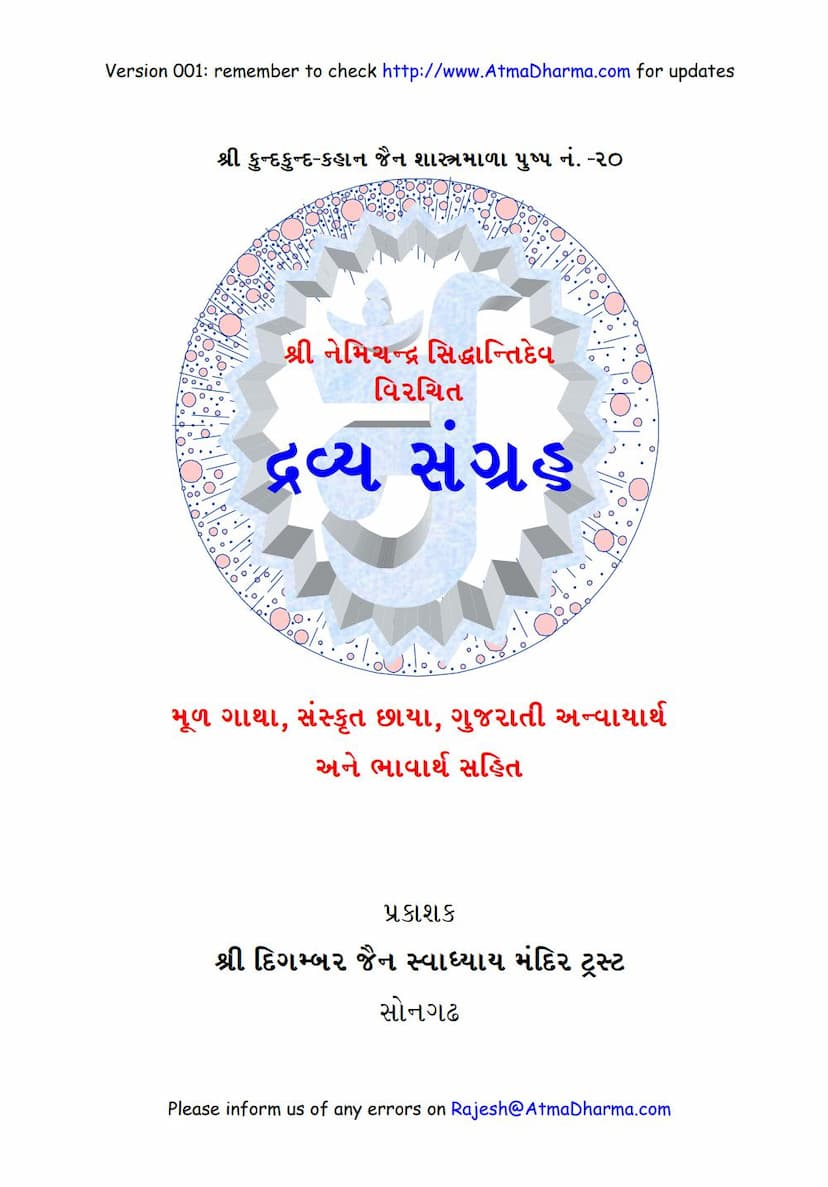Dravya Sangrah
Added to library: September 1, 2025

Summary
"Dravya Sangraha" by Acharya Nemichandra Siddhanta Chakravarti is a foundational text in Jain philosophy, specifically within the Digambara tradition. It aims to provide a concise yet comprehensive overview of Jain metaphysics, primarily focusing on the nature of reality as understood through its six substances (dravyas) and the path to liberation.
The text is structured into several key sections, each elaborating on fundamental Jain principles:
Core Principles and Substances:
-
Six Substances (Dravyas): The central theme of the book is the exposition of the six eternal, uncreated substances (dravyas) that constitute reality. These are:
- Jiva (Soul): The sentient, conscious substance, characterized by consciousness, knowledge, perception, bliss, and energy. It is the soul that transmigrates through different life forms.
- Pudgala (Matter): The only non-sentient substance with form, touch, taste, and smell. It is the only substance that undergoes change in its qualities and forms.
- Dharma (Principle of Motion): A substance that facilitates motion for other substances but does not move itself. It is omnipresent and formless.
- Adharma (Principle of Rest): A substance that facilitates rest for other substances but does not rest itself. It is omnipresent and formless.
- Akasha (Space): The substance that provides space for all other substances to exist. It is infinite and formless.
- Kala (Time): The substance that brings about change in all other substances. It is considered to have infinite temporal points.
-
Five Astikayas: Out of the six substances, Jiva, Pudgala, Dharma, Adharma, and Akasha are called Astikayas because they possess soul-like qualities (being) and have multiple spatial points (kaya). Kala, being a single temporal point, is not an Astikaya.
-
Nine Substances (Navapadartha): This section likely refers to the classification of the six substances into categories like Jiva, Ajiva (non-soul), Asrava (influx of karmas), Bandha (bondage of karmas), Samvara (cessation of influx), Nirjara (shedding of karmas), Moksha (liberation), Punya (merit), and Papa (demerit).
-
Path to Liberation (Moksha Marga): The text outlines the path to liberation, which involves understanding the true nature of the soul (Jiva) and differentiating it from non-soul substances (Ajiva). This path is typically described through the "Three Jewels" (Triratna):
- Samyak Darshana (Right Faith/Perception): Correct understanding and belief in the fundamental principles of Jainism, particularly the nature of Jiva and Ajiva.
- Samyak Jnana (Right Knowledge): Accurate and complete knowledge of the six substances and the path to liberation.
- Samyak Charitra (Right Conduct): The practice of virtuous behavior and detachment from worldly pleasures and pains, leading to the cessation of karmic influx and the shedding of existing karmas.
Key Concepts Elaborated:
-
Nayas (Viewpoints): A significant aspect of the text is its explanation of Nayas, the different perspectives or standpoints from which reality can be viewed. The primary Nayas discussed are:
- Nishchaya Naya (Ultimate/Absolute Viewpoint): This Naya focuses on the pure, intrinsic nature of substances, unadulterated by external influences or accidental qualities. It emphasizes the soul's inherent purity and self-luminosity.
- Vyavahara Naya (Conventional/Practical Viewpoint): This Naya describes substances as they appear in the empirical world, acknowledging conventional truths, relationships, and qualities, even if they are not the ultimate reality. For example, it acknowledges the soul's interaction with karmas and the body. The text highlights the importance of understanding both Nayas, as Nishchaya Naya reveals the ultimate truth of the soul's nature, while Vyavahara Naya helps in understanding the worldly process and the path towards the ultimate truth. The book emphasizes that when Nayas are discussed together, it clarifies the distinction between absolute and conventional reality.
-
Soul's Attributes: The soul (Jiva) is described as being characterized by consciousness (Upayogamaya), non-material (Amurti), a doer (Karta), of the size of its own body (Sadehaparimana), an enjoyer (Bhokta), residing in the cycle of birth and death (Sansarastha), liberated (Siddha), and naturally inclined to move upwards (urdhva-gamana).
-
Karma and Liberation: The text likely touches upon the concept of karma, the cause of bondage, and the process of shedding karma (Nirjara) through virtuous practices to achieve liberation (Moksha).
-
Pudgala's Qualities: The twenty qualities of Pudgala, such as colors, tastes, smells, and touches, are described, illustrating the material nature of the world.
Purpose and Significance:
"Dravya Sangraha" is revered for its systematic presentation of Jain doctrines in a compact form. It serves as an introductory text for students and aspirants seeking to understand the core tenets of Jainism. By elucidating the nature of substances and the path to liberation through the lens of Nayas, it aims to guide the reader towards self-realization and ultimate freedom from the cycle of birth and death. The text's clarity and logical structure have made it a widely studied and influential work in Jain literature.